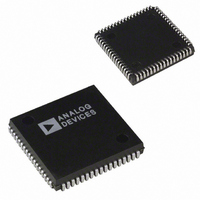ADSP-2104BP-80 Analog Devices Inc, ADSP-2104BP-80 Datasheet - Page 6

ADSP-2104BP-80
Manufacturer Part Number
ADSP-2104BP-80
Description
IC DSP CONTROLLER 16BIT 68PLCC
Manufacturer
Analog Devices Inc
Series
ADSP-21xxr
Type
Fixed Pointr
Datasheet
1.ADSP-2104BPZ-80.pdf
(36 pages)
Specifications of ADSP-2104BP-80
Rohs Status
RoHS non-compliant
Interface
Synchronous Serial Port (SSP)
Clock Rate
20MHz
Non-volatile Memory
External
On-chip Ram
1.5kB
Voltage - I/o
5.00V
Voltage - Core
5.00V
Operating Temperature
-40°C ~ 85°C
Mounting Type
Surface Mount
Package / Case
68-PLCC
Device Core Size
16b
Architecture
Enhanced Harvard
Format
Fixed Point
Clock Freq (max)
20MHz
Mips
20
Device Input Clock Speed
20MHz
Ram Size
512Byte
Program Memory Size
8KB
Operating Temp Range
-40C to 85C
Operating Temperature Classification
Industrial
Mounting
Surface Mount
Pin Count
68
Package Type
PLCC
Lead Free Status / Rohs Status
Not Compliant
Available stocks
Company
Part Number
Manufacturer
Quantity
Price
Company:
Part Number:
ADSP-2104BP-80
Manufacturer:
AD
Quantity:
13 888
ADSP-2104/ADSP-2109
A clock output signal (CLKOUT) is generated by the processor,
synchronized to the processor’s internal cycles.
Reset
The RESET signal initiates a complete reset of the processor.
The RESET signal must be asserted when the chip is powered
up to assure proper initialization. If the RESET signal is applied
during initial power-up, it must be held long enough to allow
the processor’s internal clock to stabilize. If RESET is activated
at any time after power-up and the input clock frequency does
not change, the processor’s internal clock continues and does
not require this stabilization time.
The power-up sequence is defined as the total time required for
the crystal oscillator circuit to stabilize after a valid V
applied to the processor and for the internal phase-locked loop
(PLL) to lock onto the specific crystal frequency. A minimum of
2000 t
not, however, include the crystal oscillator start-up time).
During this power-up sequence the RESET signal should be
held low. On any subsequent resets, the RESET signal must
meet the minimum pulse width specification, t
To generate the RESET signal, use either an RC circuit with an
external Schmidt trigger or a commercially available reset IC.
(Do not use only an RC circuit.)
CK
cycles will ensure that the PLL has locked (this does
Figure 2. External Crystal Connections
CLKIN
ADSP-2104/
ADSP-2109
1x CLOCK
CRYSTAL
XTAL
or
(OPTIONAL)
(OPTIONAL)
SERIAL
DEVICE
DEVICE
SERIAL
THE TWO MSBs OF THE DATA BUS (D
BOOT MEMORY EPROM ADDRESS. THIS IS ONLY REQUIRED FOR THE 27256 AND 27512.
CLKOUT
Figure 3. ADSP-2104/ADSP-2109 System
CLKIN
XTAL
RESET
IRQ2
MMAP
SCLK1
RFS1 or IRQ0
TFS1 or IRQ1
DT1 or FO
DR1 or FI
SCLK0
RFS0
TFS0
DT0
DR0
CLKOUT
RSP
BR
BG
or
SPORT 1
SPORT 0
.
ADSP-2104
ADSP-2109
DD
is
ADDR
DATA
BMS
PMS
DMS
13-0
23-0
WR
RD
23-22
–6–
) ARE USED TO SUPPLY THE TWO MSBs OF THE
14
24
The RESET input resets all internal stack pointers to the empty
stack condition, masks all interrupts, and clears the MSTAT
register. When RESET is released, the boot loading sequence is
performed (provided there is no pending bus request and the
chip is configured for booting, with MMAP = 0). The first
instruction is then fetched from internal program memory
location 0x0000.
Program Memory Interface
The on-chip program memory address bus (PMA) and on-chip
program memory data bus (PMD) are multiplexed with the on-
chip data memory buses (DMA, DMD), creating a single
external data bus and a single external address bus. The external
data bus is bidirectional and is 24 bits wide to allow instruction
fetches from external program memory. Program memory may
contain code and data.
The external address bus is 14 bits wide.
The data lines are bidirectional. The program memory select
(PMS) signal indicates accesses to program memory and can be
used as a chip select signal. The write (WR) signal indicates a
write operation and is used as a write strobe. The read (RD)
signal indicates a read operation and is used as a read strobe or
output enable signal.
The processor writes data from the 16-bit registers to 24-bit
program memory using the PX register to provide the lower
eight bits. When the processor reads 16-bit data from 24-bit
program memory to a 16-bit data register, the lower eight bits
are placed in the PX register.
The program memory interface can generate 0 to 7 wait states
for external memory devices; default is to 7 wait states after
RESET.
D 23-22
A 13-0
D
A
A
D
D
15-8
13-0
13-0
23-0
23-8
ADDR
ADDR
DATA
OE
CS
DATA
OE
WE
CS
ADDR
DATA
OE
WE
CS
PERIPHERALS
MEMORY
PROGRAM
MEMORY
(OPTIONAL)
MEMORY
(OPTIONAL)
BOOT
DATA
e.g. EPROM
&
27128
27256
27512
2764
REV. 0
















